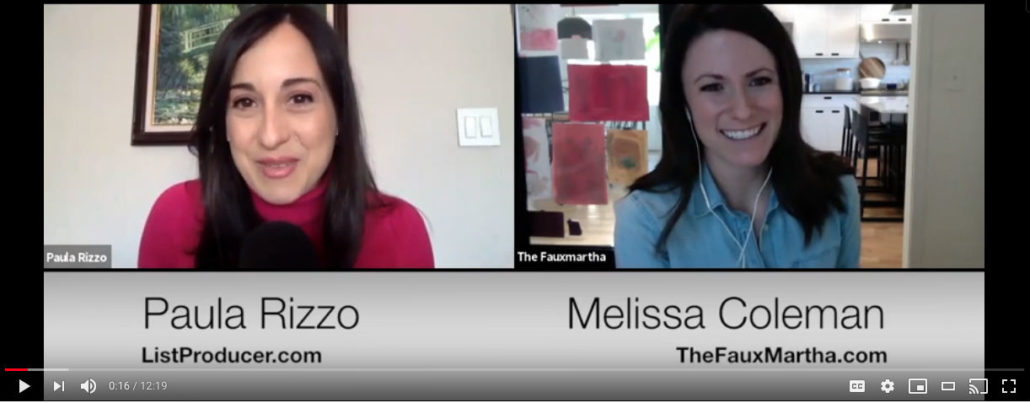BONUS FREEBIE: Want even more ways to stay organized, productive and less stressed? Click here to get access to my List-Making Starter Kit. It will boost your efficiency and get you back to doing more of the things you love.
As you know, I like to consider myself a minimalist, but there are certainly areas of my life where I am not necessarily practicing what I’m preaching. In fact, Melissa Coleman, author of “The Minimalist Kitchen,” has shown me that when it comes to cooking and organizing, I have a lot to learn.
I first met Melissa when she was one of my private media training clients.
We got along straight away, as we’re both productive and practical people. Melissa’s speciality is helping you really think about the ingredients that your using as well as cutting back on an overflowing pantry. She’s like the Marie Kondo of the kitchen.
We spoke recently about all of her best minimalism tips in this video interview:

How it all started
Melissa had always been a competent cook but, after the birth of her daughter, things started to unravel:
“I had my daughter about … she’s five now, and the kitchen completely broke for me. I did not know how to get dinner on the dinner table. It was mind-blowing, and it got to the point that I looked over at my husband and I said ‘I’m going to either quit this space or fix it.’”
A big life change can often leave us having to re-evaluate the systems we have put in place.
What worked before will not always work forever.
So how did Melissa turn it around? She invented her own system.
“The Minimalist Kitchen was born. I love food, I love to eat, and so I wanted to preserve the dinner table. And getting back to the dinner table took a long time. It took making over my pantry. It took changing my shopping habits. It took convincing my husband to change his shopping habits.”
Of course, it’s important to not just find a style that works for you, but for those you live with too. Melissa saw her kitchen like a restaurant that needed to be managed.
“I’m the restaurant owner and I need to build the system for my employees. I don’t like that hierarchy, but just for an example. And it needs to work for my employees. Like, the snack bin for my five-year-old needs to be at a place she can reach it or she’s gonna scale the pantry and it’s gonna all fall apart.”
Fixing What’s Broken
When she was looking at what wasn’t working, Melissa started with her pantry.
“I had spilling bags of pasta and rice. I had every variety of rice, because different recipes call for different varieties.”
How many different types of rice do you have? How can you combat this? Melissa explains you have to pick just one.
“What you use most, or an ingredient that you really like how it performs. I imagine if you looked in your pantry there would be one rice that you pick up every time. Or when it runs out you replace that rice, even though you’ve got five other bags. Or, the same with pasta. There’s a bunch of different varieties of pasta, and I imagine that you go pick the same one.”
As much as I hate throwing stuff away – it’s true. There’s no point keeping things we never use.
Melissa recommends getting rid of everything at the back of your pantry and learning to work with what’s at the front – the items we use most.
The Concept of Negative Space
Melissa’s background in graphic design has inspired her minimalist quest.
“I am a graphic designer by trade and before that I was a painter. A technique or a philosophy or a tool that I always grabbed was negative space, and then when I became a designer they called it white space. I realized that what I’m doing now is what I was doing then. I am trying to minimize what’s around me in my physical space to create physical white space and mental white space. Just a space to breathe and think.”
Melissa also uses a lot of lists, like I do, in order to plan her meals for the week.
“I have to write down a meal plan. I have to not only write it down, I have to see it, so we have this huge chalkboard in our house that I write the meal plan on for the week. So as I’m going throughout my week, I see that list and then I make that list.I used to loathe dinnertime, and when I see that list, I know what to do, I know what to buy at the store. I just make dinner and it feels light. It feels easy and really doable, but prior to not having a list, trusting my brain, it was not working so well.”
If you feel like you need more help, be sure to check out Melissa’s book, “The Minimalist Kitchen”. It features loads of great recipes that all use the same core ingredients -the kind of stuff you already probably have lying in your pantry. So you can spend less time shopping and more time cooking! My personal favorite is the take-out cashew chicken.
Melissa has something special coming up in the New Year. In January, she’s launching a deeper pantry cleanse tutorial. It’s taking the same concepts of the book, but taking a deeper dive, doing worksheets, really making it so practical so that you can completely makeover your kitchen. I’ll keep you posted on that because it’s something I need to do as well! We can do it together.
BONUS FREEBIE: Want even more ways to stay organized, productive and less stressed? Click here to get access to my List-Making Starter Kit. It will boost your efficiency and get you back to doing more of the things you love.


